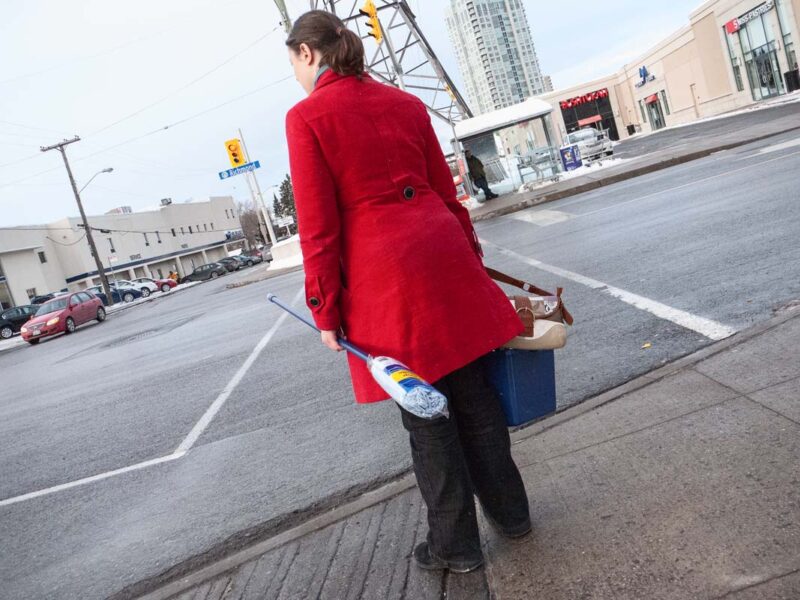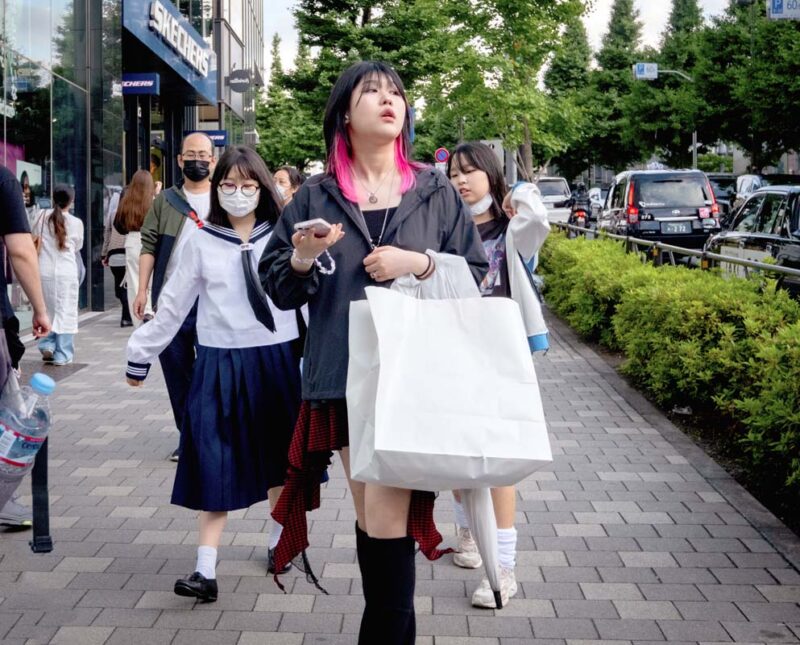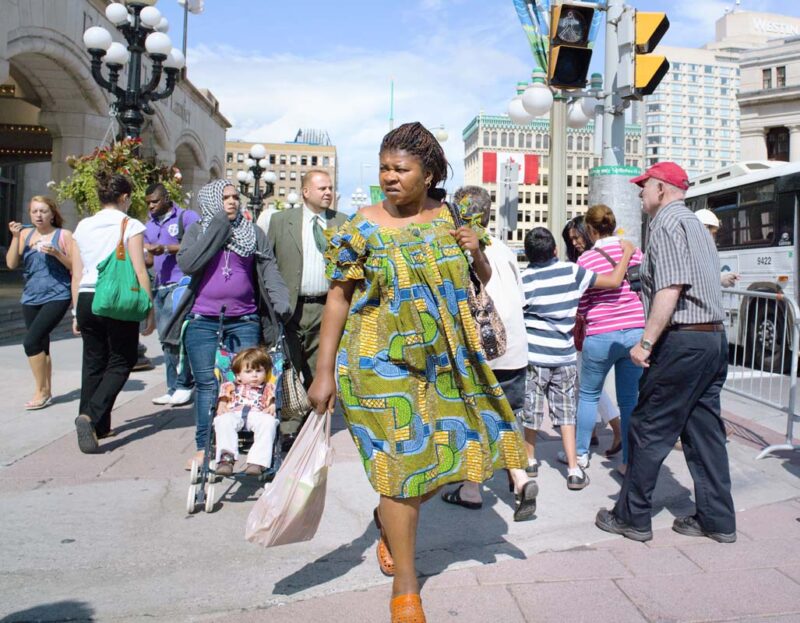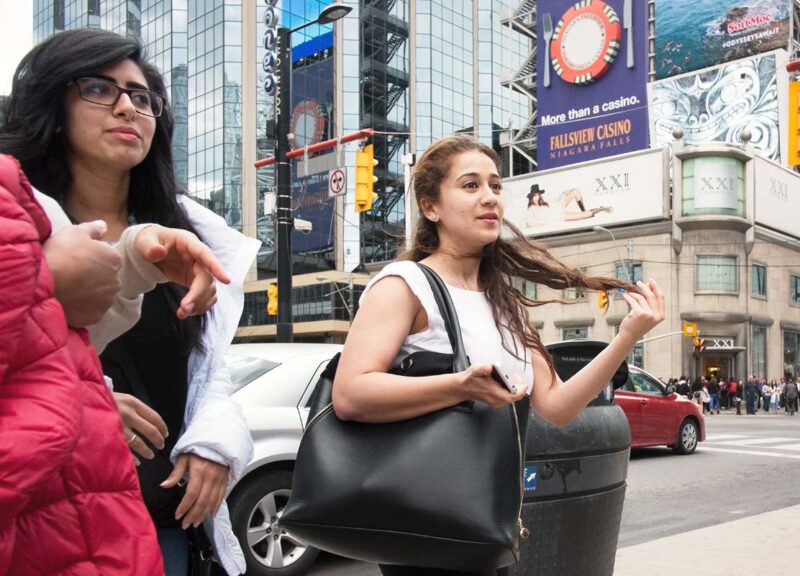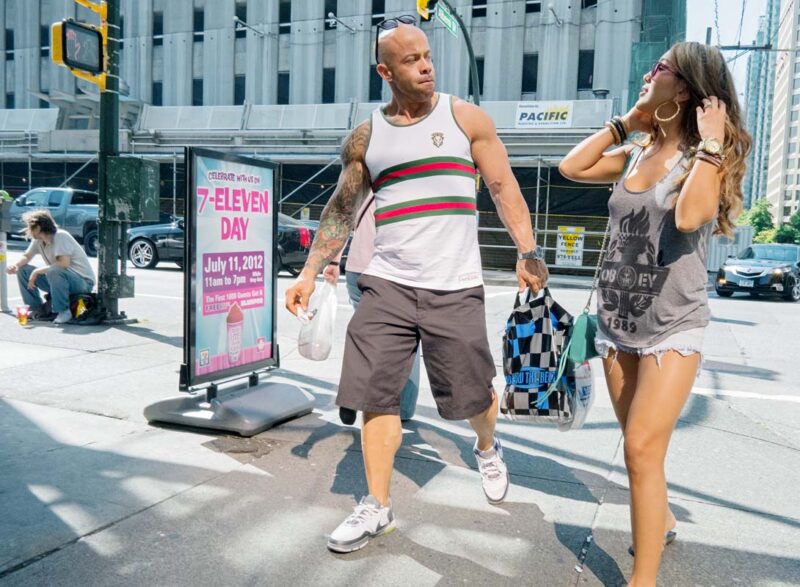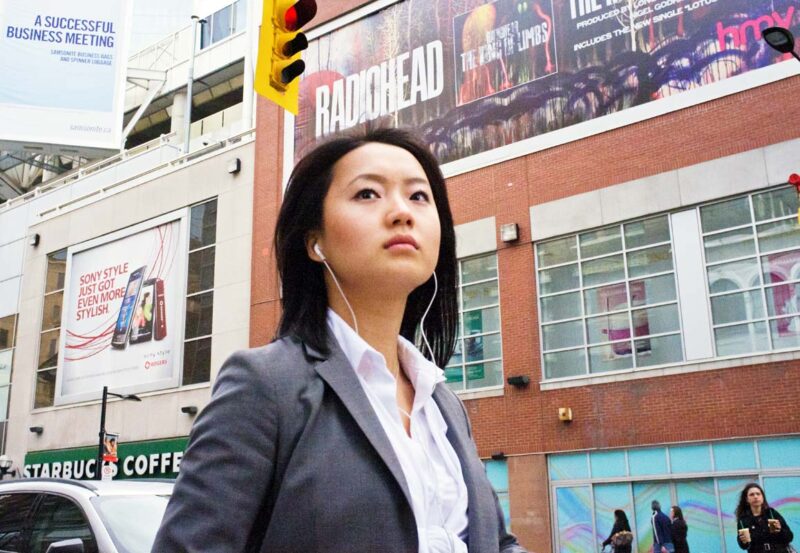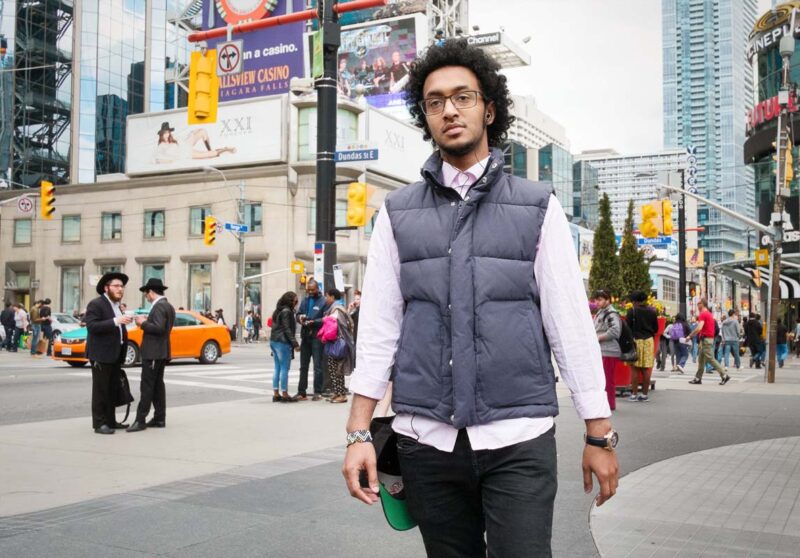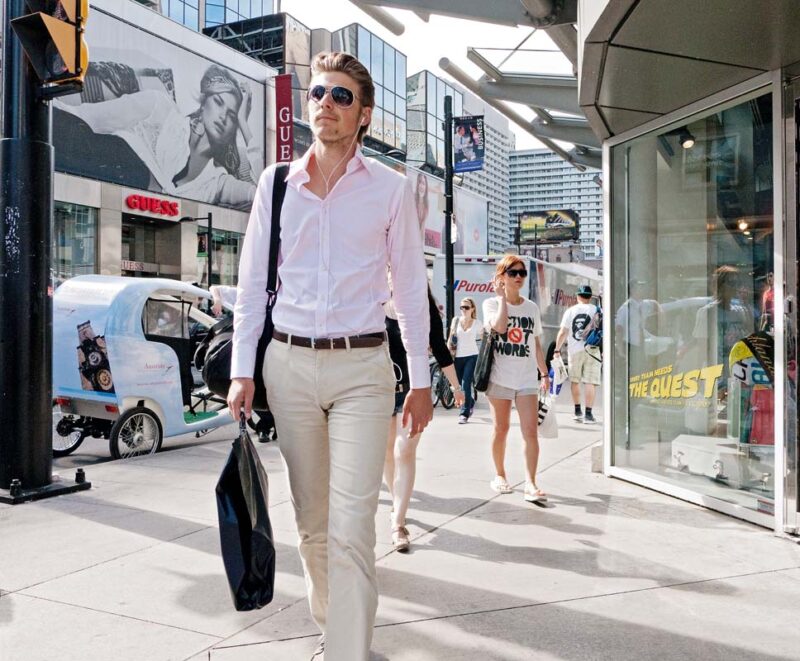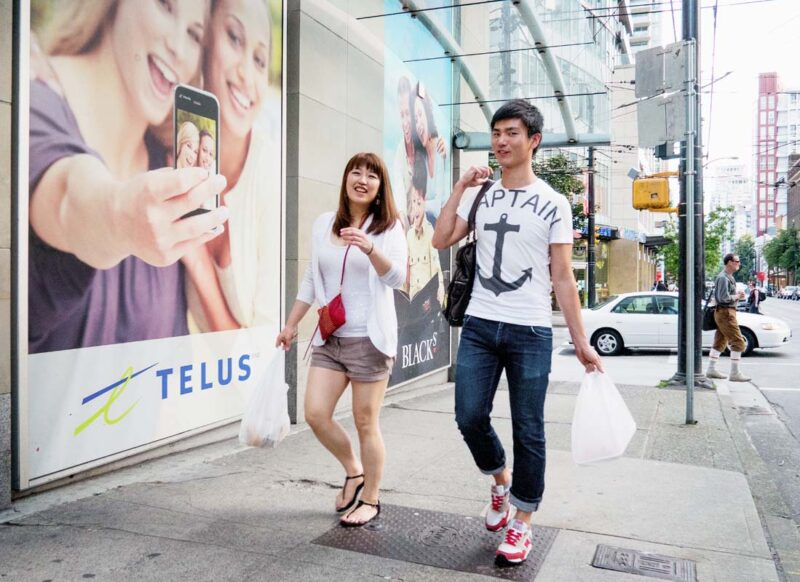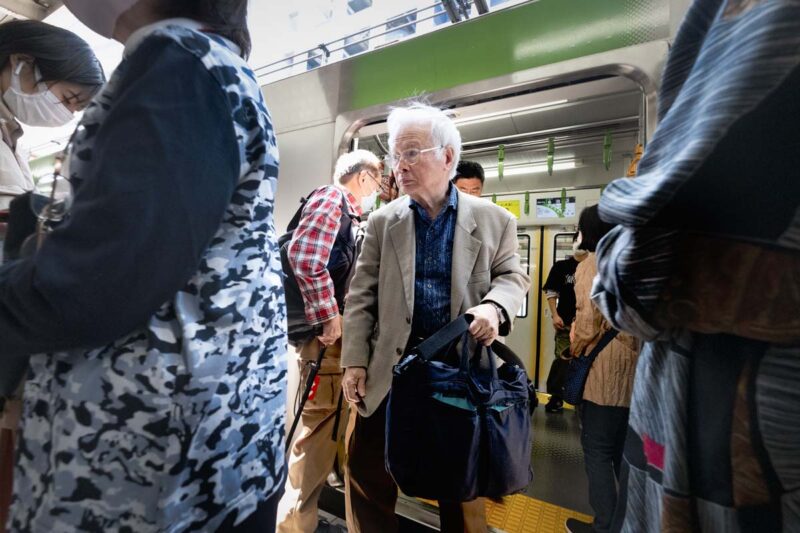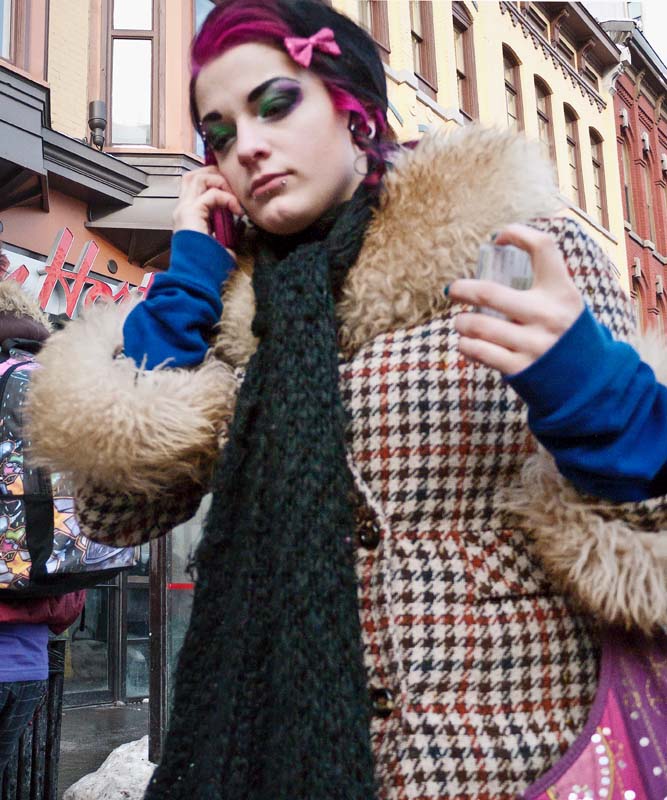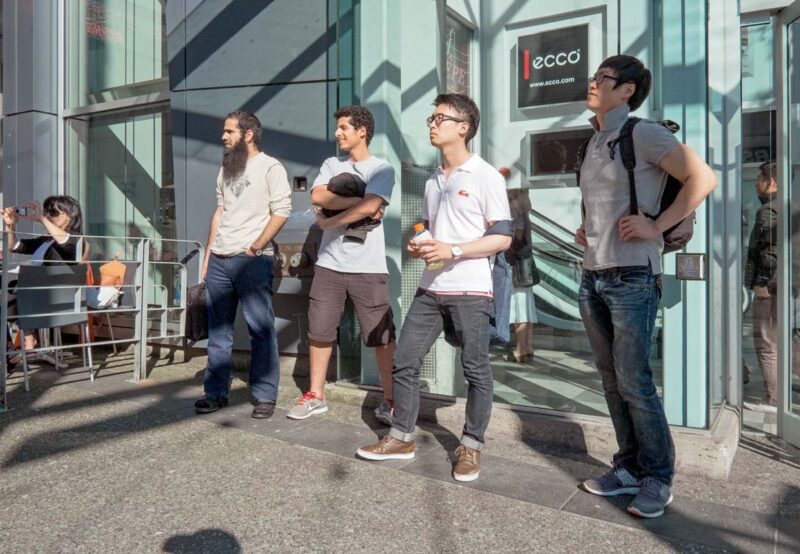[Summer 2024]
Observing the Theatre of the Streets
by Pierre Dessureault
[EXCERPT]
Following in the street-photography tradition, Ontario photographer Justin Wonnacott has been scrutinizing life in cities in Canada and elsewhere for more than three decades. The images that he has brought together in Figureground highlight the uniqueness of his approach, which has evolved over the years in phase with technological advances.
It has been a long road to Wonnacott’s twenty-first-century digital snapshots, which join the deluge of images from all sources saturating the public space. It all started with Louis Daguerre’s singular picture, in 1839, of Boulevard du Temple in Paris, in which we glimpse the frozen silhouette of a man having his shoes shined: his immobility is stamped into the insensitive silver plate of the daguerreotype and all activity on the street has disappeared, wiped away by the long exposure time. Between Daguerre and Wonnacott, there was the invention of the Leica, and then Henri Cartier-Bresson’s pronouncement of the “decisive moment” – that fraction of a second in which all elements of the scene fall, almost miraculously, into place to compose an image of almost-perfect proportions. Then came Harry Callahan, who, in his photographs of fixed visual architectures, merged passersby with the urban environment in compositions verging on the abstract; Robert Frank, who captured the transient in snapshots that abandoned an accurate description for an assumed subjectivity; William Klein, who strolled the streets of New York, Rome, Moscow, and Tokyo and used blurs, inexact framings, and exaggerated contrasts to defy the “good photography” of his time; Dave Heath, who searched crowds of anonymous passersby for faces with legible thoughts and emotions; Garry Winogrand, Lee Friedlander, and Nathan Lyons, who probed a “social landscape” in which human figures competed with oppressive buildings and with advertising that, slowly but surely, was colonizing the public space. All were milestones and fractures in a history that has inexorably marched on.
Wonnacott is familiar with such questions about the nature and use of images. Indeed, he explored the shifting borders between documentary and fiction in two groups of works produced during the 1990s, one in Berlin and the other in Ottawa. Berlin 1990–1991 is situated at a historical turning point: the fall of the Berlin Wall and the reunification of the two Germanys. Distancing himself from the conventional images put out by media outlets, Wonnacott observed Berliners’ street life and daily activities during two stays spread over several months. His project took shape in two phases: he took a series of snapshots with a 35 mm camera, which served as reference points or sketches for the scenes that he later captured with a large-format camera in the same settings, with paid actors. This documentary fiction highlighted the photographer’s role as director of the social fact – as master of the image of reality produced by re-creating, and transposing, observed reality and adding his own experience to it.
The project about Somerset Street in Ottawa, produced in the late 1990s, was “documentary” in nature, if this hackneyed term still means anything. Wonnacott inhabited the neighbourhood: systematically and methodically, his frontal views detail the motley profusion of signs on the fronts of small multi-ethnic businesses that characterize this emblematically diverse street. His description of the place’s configuration and his images’ commandeering of this abundance of cultures produced a focused and embodied portrait of the unique social fabric of a multifaceted neighbourhood.
“I see street pictures as history or as a reflected story about self and privacy but mostly as a necessary gesture which must not be wasted,” Wonnacott says. Aware of photographers’ responsibility to participate in the social life of their community, he publishes images in a blog, sharing them to open up a space for dialogue among residents. By returning his photographs to his subjects in this way, he abdicates his position as demiurge and becomes an active witness who not only captures the visual configuration of a neighbourhood that he visits often and has known for a long time, but also willingly engages in a relationship with his subjects in the present moment. Images thus become spaces for exploration and exchange, an opportunity for a wide variety of individuals to come to a meeting of minds.
In the spontaneous photographic gestures featured in Figureground, Wonnacott comes to grips with the bustle of urban life in images that gather, at ground level and in a disorganized way, an abundance of signs of material life borne by a complex network of oblique lines, precarious perspectives, incongruous associations, and improbable encounters. This sweeping cross section of fluid reality, fixed in the instant of Wonnacott’s gaze – his vision, knowledge, and coincident movements becoming part of the construction of the images – is offered not as a simple reflection of reality but as the culmination of a culture that he and his subjects share. His unrehearsed, partly reflexive actions inform the specificity of his photographic work and also highlight the medium’s unique capacity to capture all the complexities of life. The vision expressed through the camera freezes on the flat surface of the image, once and for all, the view of an eye moving through the disorder of the ephemeral. No redoes are possible here, as they are in the visual arts. The image imposes an integral reality that is its own and sufficient unto itself.
By accumulating on its surface the material signs of social life and ordering them according to its own rules, images become stories: “A story . . . is an arrangement of actions according to which there has not been simply been this and then that, but configuration that fits the facts together and allows them to be presented as a whole.” The cities in which Wonnacott works – Toronto, Montreal, Ottawa, Vancouver, Tokyo, and The Hague – are captured from the point of view of the anonymous pedestrian among other anonymous pedestrians, observer of the social theatre that is presented to his gaze. Everywhere the urban space displays the same lurid ads. North American, Japanese, and Dutch people wear the same globalized brand-name clothing. Nothing makes these places unique or distinguishes them on the cultural level. What they have in common is the fantasy of merchandise omnipresent in the urban space, which speaks volumes about collective values.
Although images transform an instant into a story by crystallizing it, they are inscribed, in their turn, in the succession of technical improvements to the photographic medium, advances in knowledge, and cycles of metamorphosis of portrayals of the urban space. “Now every picture is in color,” Wonnacott writes, “and with modern gear I can gesture with a camera and see moments more freely than with yesterday’s equipment. The experience of walking – and being – on the street is very different compared to the streets of 25 or 35 years ago… Photographs are constantly being churned out by the cameras on the street by tourists, kids sharpshooting with cellphones or by the growing numbers of surveillance cameras which relentlessly monitor parts of our cities for our own protection.”
Figureground, Berlin 1990–1991, Somerset Street – all are different ways of capturing the materiality and historicity of cultures as they are produced: signs are not disembodied abstractions but tangible products of the activity of human beings who, by imposing their presence in the urban space, imbue it with meaning. There are no codes, laws, or rules for deciphering these image enigmas, which freeze a furtive gaze in a unique gestural language.
Translated by Käthe Roth
[ Complete issue, in print and digital version, available here: Ciel variable 126 – TRAJECTORIES ]
[ Complete article, in digital version, available here: Justin Wonnacott, Figureground — Pierre Dessureault, Observing the Theatre of the Streets
]

